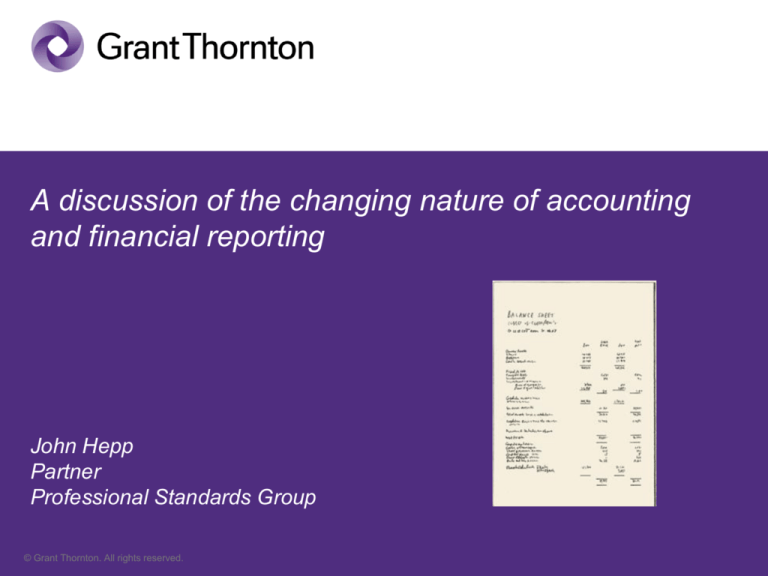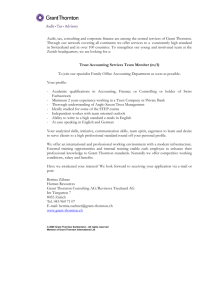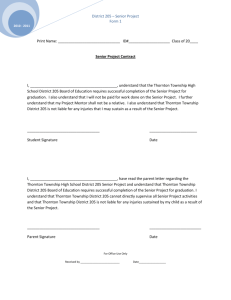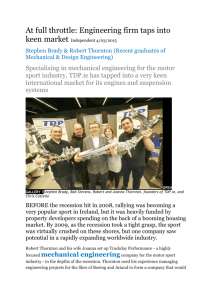
A discussion of the changing nature of accounting
and financial reporting
John Hepp
Partner
Professional Standards Group
© Grant Thornton. All rights reserved.
Disclaimer
This presentation is not a comprehensive analysis of the subject matters covered and may
include proposed guidance that is subject to change before it is issued in final form. All
relevant facts and circumstances, including the pertinent authoritative literature, need to be
considered to arrive at conclusions that comply with matters addressed in this presentation.
The presentation is not intended to provide accounting or other advice or guidance with
respect to the matters covered.
The views and interpretations expressed in the presentation are those of the presenter and
not of Grant Thornton LLP.
All opinions
are strictly my
own
© Grant Thornton. All rights reserved.
Thomas Kuhn: The Structure of Scientific
Revolutions (1962)
• A paradigm is what members of a scientific community, and
they alone, share
• A paradigm shift is a change in the basic assumptions, or
paradigms, within the ruling theory of science
• Accounting and financial reporting
are in the middle of a
paradigm shift
© Grant Thornton. All rights reserved.
IFRS Agenda and the pace of change
Financial Crisis Projects
© Grant Thornton. All rights reserved.
The convergence projects
© Grant Thornton. All rights reserved.
And a new conceptual framework…
now running late
© Grant Thornton. All rights reserved.
Deferred projects to be resumed later in 2011
•
•
•
•
•
Financial Statement Presentation
Financial Instruments with Characteristics of Equity
Emissions Trading Schemes
Liabilities
Income Taxes
© Grant Thornton. All rights reserved.
Questionable support for a rapid pace of change
During 2011, the FASB and the IASB plan to issue standards that
will include major revisions to the current accounting. How should
these standards be implemented in the U.S.?
Item
Use an incremental approach where no more than
one major standard takes effect in a given
reporting year
The Boards should defer major changes in the
financial reporting model until the projects have
been more fully developed and field-tested
Use a “big bang” approach to improve the
financial reporting model as quickly as possible
The standards should be implemented first in
IFRS; U.S. companies can adopt the standards on
adoption of IFRS
© Grant Thornton. All rights reserved.
Count
Percent %
89
37%
66
27%
48
20%
40
16%
The Global Convergence Project
Convergence
US GAAP
© Grant Thornton. All rights reserved.
IFRS
Convergence
The European View
Convergence
US GAAP
© Grant Thornton. All rights reserved.
IFRS
Convergence
The American view
Convergence
US GAAP
© Grant Thornton. All rights reserved.
IFRS
Or something else?
A new accounting model
US GAAP
© Grant Thornton. All rights reserved.
IFRS
CFO survey results
Still looking for consensus
When should the U.S. adopt IFRS for public companies?
Item
After U.S. GAAP and IFRS have converged
(5-7 years)
Count
Percent %
136
49%
As soon as possible (2-5 years)
72
26%
The U.S. should not adopt IFRS and focus on
issuing high-quality standards
45
16%
The U.S. should not adopt IFRS but have an
ongoing goal of issuing converged standards
24
9%
© Grant Thornton. All rights reserved.
Dueling paradigms
The battle to define accounting
© Grant Thornton. All rights reserved.
Dueling paradigms
• The legal model: Financial reporting provides information
about property rights and obligations of entities to creditors
and owners and the results of past transactions
• The finance model: Financial reporting provides information
about future cash flows to allocate capital (set prices in
capital markets)
Conflict between the two models has been described as
"religious warfare"
© Grant Thornton. All rights reserved.
A legal perspective:
General Purpose Financial Reporting
• A focus on the results of past transactions
• Transactions establish legal rights and
obligations, enforceable at law
• A focus on stewardship and performance
• Income and return on investment
• And conservative measurement of income
• Recognize losses when incurred; income when realized
• Net income defined as the amount of resources that can safely be
distributed from an entity whose owners have the privilege of limited
legal liability
© Grant Thornton. All rights reserved.
Mixed attribute accounting model
Motivation: accountability for assets, measurement of profit or loss
© Grant Thornton. All rights reserved.
A finance perspective
Information for Investors and Creditors
• A focus on investors’ investment decisions
• Information for capital allocation
• Rational decisions in efficient markets
• A focus on future cash flows
• Valuation based on discounted future cash flows
• Amounts from past transactions are irrelevant
• Unbiased recognition
• Recognize gains and losses when estimable
• No need for a transaction, legal right or legal obligation
© Grant Thornton. All rights reserved.
Cohesiveness and financial statement presentation
Proposed
Motivation: Accounting as forecasts of future cash flows
Cohesive cash flows
Statement of
Financial Position
Core operating,
investing and
financing activities
Revenue Recognition
Asset/Liability Recognition
Remeasurement
Derecognition
Statement of
Comprehensive
Income
Statement of Cash
Flows
Cash receipts and
disbursements
Core activities
Free cash flow
Noncore
Noncore
Noncore
Financing
Financing
Financing
Statement of Forecasted
Future Cash Flows
Statement of Changes in
Forecasted Future Cash
Flows
Statement of Cash Flows
This statements is
now the residual
and does not
inform valuation
Direct method
cash flows
Initial recognition
and subsequent
changes
measured at exit
value
© Grant Thornton. All rights reserved.
CFO survey results
Net income or
comprehensive income?
Which of the following are considered to be primary
performance indicators by the users of your financial
statements? (Select all that apply.)
Item
Cash flow from operations
EBITDA
Net income
Free cash flow
Earnings per share
Forward-looking financial
information (i.e., forecasts)
Comprehensive income
© Grant Thornton. All rights reserved.
Count
Percent %
154
135
129
84
68
63%
55%
53%
34%
28%
56
43
23%
18%
Is double entry bookkeeping still relevant?
• How should financial statements articulate?
• What do we do with "undesirable" debits and credits?
– Other comprehensive income
– "Unrecognized" assets and liabilities
– Deferred costs and charges
– Prepaid expenses
and unearned revenue
© Grant Thornton. All rights reserved.
The objective of financial reporting
© Grant Thornton. All rights reserved.
Objective of General Purpose Financial Reporting
A more traditional approach
The objective of financial statements is to provide
information about the financial position, performance and
changes in financial position of an entity that is useful to a
wide range of users in making economic decisions.
© Grant Thornton. All rights reserved.
CBRM
The primary objective of financial reporting is
“to provide all of the information that owners of common equity require
to evaluate their investments. Common shareowners use this information
to make forecasts of future cash flows, evaluate the sustainability of the
company’s business model, and assess its cash-generating ability. This
information, in turn, is used to estimate the investments’ value and future
changes in such value.”
“Fair value information is the only information relevant for financial
decision making”
© Grant Thornton. All rights reserved.
The new framework
Conceptual Framework for Financial Reporting
September 2010
• OB2. The objective of general purpose financial reporting is to
provide financial information about the reporting entity that is
useful to present and potential equity investors, lenders, and other
creditors in making decisions about providing resources to the entity.
Those decisions involve buying, selling, or holding equity and debt
instruments and providing or settling loans and other forms of credit.
• Original version referred to "making decisions in their capacity as
capital providers."
© Grant Thornton. All rights reserved.
Financial reporting provides information to help the
reader prepare an assessment of future cash flows
OB3. Decisions by existing and potential investors about buying,
selling, or holding equity and debt instruments depend on the returns
that they expect from an investment in those instruments...Investors’,
lenders’, and other creditors’ expectations about returns depend on
their assessment of the amount, timing, and uncertainty of (the
prospects for) future net cash inflows to the entity. Consequently,
existing and potential investors, lenders, and other creditors need
information to help them assess the prospects for future net cash
inflows to an entity.
© Grant Thornton. All rights reserved.
A minor problem
© Grant Thornton. All rights reserved.
CFO survey results
Valuation or performance?
Which of the following describes the objective of financial
reporting by your company?
Item
To provide information about past transactions and
events so that users may evaluate your performance
according to your business model and earnings
To provide information on economic resources,
claims to those resources and changes to them so
that users may estimate the nature, timing and risk
of your future cash flows
None of the choices describe our objective for
financial reporting.
To provide information about the nature, timing and
risk of your future cash flows
© Grant Thornton. All rights reserved.
Count
Percent %
141
58%
47
19%
30
12%
27
11%
CFO survey results
Owners or potential investors?
What is the primary reason that your firm prepares audited
financial statements?
Item
To provide information on financial position and
performance to owners of the firm
To meet other legal requirements
To obtain loans or other credit
To demonstrate compliance with loan covenants
To provide information useful for valuing equity
and debt securities of the firm
Other
© Grant Thornton. All rights reserved.
Count
Percent %
97
45
38
35
40%
18%
16%
14%
21
9
9%
4%
My view of the objective of financial reporting
Also found in paragraph 12 of the framework!
OB12. General purpose financial reports provide information about the
financial position of a reporting entity, which is information about the
entity’s economic resources and the claims against the reporting entity.
Financial reports also provide information about the effects of
transactions and other events that change a reporting entity’s economic
resources and claims. Both types of information provide useful input for
decisions about providing resources to an entity.
© Grant Thornton. All rights reserved.
Qualitative characteristics
A complete rewrite
• Changes the definition of qualitative characteristics
– From: desired qualities when making accounting choices
– To: the qualities that identify the types of information that are likely to
be most useful to the existing and potential investors, lenders, and
other creditors
• Eliminates the equal status of relevance and reliability
• Replaces reliability with representational faithfulness
© Grant Thornton. All rights reserved.
Elemental differences
© Grant Thornton. All rights reserved.
The fundamental element
• OLD definition of an asset
– Assets are probable future economic benefits obtained or controlled
by a particular entity as a result of past transactions or events.
• Proposed NEW definition of an asset:
– An asset of an entity is a present economic resource to which the
entity has a right or other access that others do not have.
• What is an economic resource?
© Grant Thornton. All rights reserved.
What is wrong with the old definition?
According to the staff…
• Some users misinterpret the terms “expected” (IASB definition) and
“probable” (FASB definition) to mean a high likelihood of future
economic benefits; items with low likelihood would be excluded
• Too much emphasis on identifying the future flow of economic benefits,
instead of focusing on the item that presently exists
• The definitions place undue emphasis on identifying the past
transactions or events that gave rise to the asset
• Interpret control in the same sense as that used for purposes of
consolidation accounting
– The term should focus on whether the entity has some rights or
privileged access to the economic resource
© Grant Thornton. All rights reserved.
And the same with liabilities
• Old definition of a liability
– Liabilities are probable future sacrifices of economic benefits arising
from present obligations of a particular entity to transfer assets or
provide services to other entities in the future as a result of past
transactions or events
• New proposed definition
– A liability of an entity is a present economic obligation for which the
entity is the obligor
• How does an economic obligation differ from a legal obligation?
© Grant Thornton. All rights reserved.
Legal rights and obligations
Or estimated future cash flows?
• When to recognize a cost: when incurred or when
estimable?
– Lease accounting issues and contingencies bring this
issue to the forefront
• When to recognize an asset: when earned or when
estimable?
– One of the core issues of fair value accounting
© Grant Thornton. All rights reserved.
My own views
Multiple elements
The definition of an asset is flawed
• Cash in the currency of account is a separate element
• Must be based on rights at law (from a past transaction)
• Goodwill is a separate type of asset
– Estimated future cash flows
– Different unit of account
• Government actions that create legal rights such as
patents, copyrights and quotas are also transactions
© Grant Thornton. All rights reserved.
Executory contracts
© Grant Thornton. All rights reserved.
Executory contracts
The US SEC identifies the options
1. Recognize all contractual rights and obligations as assets
and liabilities.
2. Do not recognize contractual rights and obligations as
assets and liabilities.
3. View the contractual rights and obligations within a
particular contract as a group, and recognize the group as
an asset or liability.
Standard setters traditionally have selected the second option
© Grant Thornton. All rights reserved.
CFA Institute prefers the first option
…that all activities that currently are off balance sheet as a result of
accounting standards or other conventions must be recognized,
including executory contracts. Executory contracts, arrangements for
which performance by the various parties is still in progress, represent
commitments entered into by the parties. These commitments will affect
shareowners’ wealth and should be recognized as any other obligation
would be.
© Grant Thornton. All rights reserved.
The asset and liability approach to standard setting
In the asset/liability view, the standard setter .. would, first, attempt to
define and specify the measurement for the assets and liabilities that
arise from a class of transactions. The determination of income would
then be based on changes in the assets and liabilities so defined
Executory contracts and the asset/liability approach will be key to
determining the accounting for revenue recognition and leases.
© Grant Thornton. All rights reserved.
A conceptual framework for fair value
© Grant Thornton. All rights reserved.
Fair value is somewhat misleading
• Fair Value: The price that would be received to sell an asset or paid to
transfer a liability in an orderly transaction between market participants
at the measurement date
– Fair value equals exit value
• Principle: In all instances, the reporting entity shall maximize the use of
relevant observable inputs and minimize the use of unobservable
inputs.
– Level I = market value (Max: Observable, Unobservable = 0)
– Level II = equivalent market value (Observable > Unobservable)
– Level III = hypothetical market value (Unobservable > Observable)
© Grant Thornton. All rights reserved.
Assumptions matter
• “Indeed, in the context of completely frictionless markets, where assets
trade in fully liquid markets and there are no problems of perverse
incentives, accounting would be irrelevant since reliable market prices
would be readily available to all.”
• In the real world, there are transaction costs:
– Search and information costs
– Bargaining costs (how much is this worth)
– Policing and enforcement costs (making sure the other party sticks
to the terms of the contract)
© Grant Thornton. All rights reserved.
What is market value?
• Is fair value the intrinsic value of the asset or liability?
• In fair value accounting, an observable value in an active market is
equal to underlying value:
Error = zero
• In my opinion this is not correct. Market values, even values from an
active market, are only an estimate of an unknown underlying value:
V= (v + e)
Where V is an estimate of the underlying value v
plus an error term e whose expected error is zero
(and normally distributed)
© Grant Thornton. All rights reserved.
Is fair value equal to intrinsic value?
Case study: US Housing Markets
"Mr. Greenspan's Cappuccino" Commentary by
Brian S. Wesbury, Wall Street Journal, May 31, 2005.
© Grant Thornton. All rights reserved.
Market value may not always be relevant
and may lead to pro-cyclicality
If the purpose of the exercise is to assess the soundness of the
aggregate household sector balance sheet, then the marked-to-market
value of the total US housing stock (assessed at the current marginal
transaction price) may not be a good indicator of the soundness of the
aggregate balance sheet. Instead, it would be better to ask how much
value can be realized if a substantial proportion of the housing stock
were to be put up for sale. The value realized in such a sale would be
much smaller than the current marked-to-market value. This is one
instance in which marking to market gives a misleading indicator of the
aggregate position.
"Fair Value Accounting and Financial Stability" by Guillaume Plantin.
Haresh Sapra and Hyun Song Shin (2008)
© Grant Thornton. All rights reserved.
Financial Instruments
Never let a crisis go to waste
© Grant Thornton. All rights reserved.
Two different models for financial instruments
• FASB
– Fair value with limited exceptions
• IASB
– Amortized cost with a limited fair value option
© Grant Thornton. All rights reserved.
FASB visited by a Christmas spirit
• The FASB proposal drew heated criticism, including
more than 2,800 comment letters and
passionate remarks at a series of roundtables
• Just before breaking for the Christmas holiday,
all five members of the board said that they are
"open to considering" other measurement approaches
for certain financial assets
• The FASB tentatively agreed on January 25, 2011,
to revise its approach to classifying and measuring financial assets by
narrowing the circumstances under which financial assets would be
subject to fair value accounting
© Grant Thornton. All rights reserved.
Audit implications
• The changes to the FASB proposal to use fair value for all
loans is an improvement
• We do not believe the proposed impairment model is
implementable
• Measurement will be more labor intensive
• Auditing will be more labor intensive
• The financial statements will be
more difficult to understand
© Grant Thornton. All rights reserved.
Revenue Recognition
© Grant Thornton. All rights reserved.
Revenue Recognition
Issues
• Executory contracts
– When do you recognize the assets and liabilities arising
from a sales contract?
• Asset/liability approach
– Is control over a service operational?
© Grant Thornton. All rights reserved.
Example 29 from the ED
January 1
March 31
April 30
A vendor enters into a contract with the customer for
$1,000
The vendor transfers control of the product to the
customer
The customer pays the vendor
© Grant Thornton. All rights reserved.
Example 29 from the ED
January 1, contract inception
No entry
March 31, control transferred
Dr. Receivable
Cr.
Revenue
April 30, payment received
Dr. Cash
Cr.
Receivable
$1,000
$1,000
$1,000
$1,000
From the journal entries provided in the ED, it is not observable how or
when the performance obligation was created or satisfied and therefore,
it is not observable how revenue was generated.
© Grant Thornton. All rights reserved.
Recording the executory contract
January 1, contract inception
Dr. Contract asset (memo)
$1,000
Cr. Performance obligation (memo)
March 31, control transferred
Dr. Receivable
$1,000
Cr. Contract asset (memo)
Dr. Performance obligation (memo) $1,000
Cr. Revenue
$1,000
$1,000
$1,000
The performance obligation is satisfied and revenue is recognized
© Grant Thornton. All rights reserved.
A change in accounting principle
Revenue recognition = Satisfaction of a performance obligation
The initial principle…
Satisfaction of a
performance obligation = Transfer of a good or service to a customer
is transformed…
Transfer of a good or
service to a customer = Customer obtains control of a good or service
to a different principle
Revenue recognition = Customer obtains control of a good or service
© Grant Thornton. All rights reserved.
Cross cutting issues
• A model that focuses on derecognition of the performance
obligation instead of transfer of control may prove to be
more understandable to both preparers and readers of the
financial statements
• The issue of executory contracts extends beyond revenue
recognition
– The accounting for purchases
– The accounting for leases
© Grant Thornton. All rights reserved.
A private conceptual framework:
Revenue recognition
Paragraph 5
5. The objective of the proposed guidance is to establish the
principles that an entity shall apply to report useful information to
users of its financial statements about the amount, timing, and
uncertainty of revenue and cash flows arising from a contract with
a customer.
Question 10 - The objective of the Boards’ proposed disclosure
requirements is to help users of financial statements understand
the amount, timing, and uncertainty of revenue and cash flows
arising from contracts with customers. Do you think the proposed
disclosure requirements will meet that objective? If not, why?
© Grant Thornton. All rights reserved.
Our response
We think the proposed disclosure objective is inconsistent with
The Conceptual Framework for Financial Reporting 2010. That
document (at OB3 for example) explains that the users of financial
statements make an assessment of prospects for future net cash
inflows to an entity.
The proposed objectives in paragraph 5 and in paragraph 69 could
be viewed as shifting responsibility from the user to the reporting
entity to make the assessment of the amount, timing and
uncertainty of future cash flows.
© Grant Thornton. All rights reserved.
Audit issues
• More focus on contracts than shipping or billing documents
• Allocation of revenue to multiple element contracts
• Onerous contracts
© Grant Thornton. All rights reserved.
Lease Accounting:
A Whole New Ballgame
© Grant Thornton. All rights reserved.
Scope: When is a lease a sale, a partial sale, or an
executory contract?
Boundary determined
by control at the end
of the lease term
Sale of a
good
Revenue recognition
standard
Boundary for
distinct services
Derecognition
approach
(partial sale)
Performance
obligation
(lease)
Lease accounting
standard
Performance
obligation
(service)
Revenue recognition
standard
The Boards have not redeliberated this model but are likely to
make changes based on decisions made about lessee accounting
© Grant Thornton. All rights reserved.
The "right of use" asset model
Boundary determined
by control at the end
of the lease term
Purchase
of a good
IAS 16 or ASC 360
Property, Plant
and Equipment
Boundary for
distinct services
Right-ofuse asset
Lease accounting
standard
Purchase
of a service
Executory contract
no recognition
The original model as presented in the Exposure Draft
© Grant Thornton. All rights reserved.
The right of use asset model is breaking down
Boundary to be
determined
Financing
Lease
Right of use asset,
amortized liability
© Grant Thornton. All rights reserved.
Boundary for distinct
services from
Revenue Recognition
Other leases
Straight-line recognition?
Purchase
of a service
Executory contract
no recognition
Leases
Example – lessee accounting
• 5 year lease of office space with 5 year renewal at market
• Initial monthly rent of $100,000
• Rent increases by 2% each year
• Lessee's incremental borrowing rate is 9%
© Grant Thornton. All rights reserved.
Income statement
Frontloading of expense for lessees, revenue for lessors
Thousands
5 year lease no renewal
$130
$120
$110
$100
Cash
$90
Current GAAP
$80
Proposed
$70
1
13
25
37
Months
© Grant Thornton. All rights reserved.
49
Other audit issues
•
•
•
•
•
How to distinguish between a lease and a service contract
Accounting for multiple element lease contracts
How to measure an impaired right of use asset
Determining the lease term
Measuring contingent rents
© Grant Thornton. All rights reserved.
Conclusion
© Grant Thornton. All rights reserved.
More than a cosmetic change
• “The intellectualization of financial reporting in the shadow of financial
economics is not just a matter of technical measurement – it is a
blueprint for redesigning the knowledge base of an entire profession.”
Michael Power, Professor of Accounting, London School of Economics and
Political Science
• Previous core competencies based on accounting conventions are
being replaced by valuation techniques.
• Preparing, auditing, and understanding fair value
measurements a whole new set of skills
© Grant Thornton. All rights reserved.
Some additional reading
© Grant Thornton. All rights reserved.
Questions or comments?
© Grant Thornton. All rights reserved.








